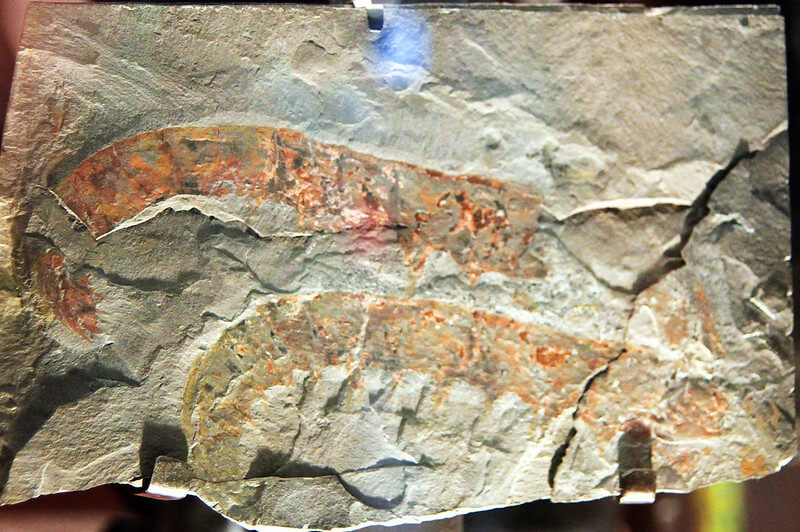After a Million Years, a Lobster Is Loose
By Carrie Laben
Broadcast 8.2011, 12.2014, 12.2018, and 9.21 & 9.24.2022

Anomalocaris fossil, photo by Tim Evanson, CC-by-SA 2.0.
Listen:
It’s cloudy and damp. Better to be indoors. As my friend Megan and I walk through the halls of the University of Montana’s Geology department, we pass a glass case containing the skull and arm bones of a Tyrannosaurus rex. “Peck’s Rex” was found just outside Fort Peck, Montana, in 1997, but we stop to admire it only briefly; we’re on our way to check out a much smaller, but equally, I think, exciting fossil discovered in the same area.
In the last Cretaceous period, from 90 to 65 million years ago, Montana had a lusher climate than today. The Rocky Mountains formed one edge of a vast inland sea that completely split what we now know as North America. Massive fish and marine reptiles cruised the waters, while dinosaurs—from Troodon, a raptor about the size of a great dane, to the massive T. rex—shared the swampy forests along the shores with primitive mammals.
Fort Peck was beachfront property on the edge of that sea. As a result, there are three distinct sedimentary rock formations from that era running through the area. The T. rex was found in the Hell Creek formation, just inland from the ancient coast. The sparsely fossiled Fox Hill sandstone is a remnant of the beach itself. And the third formation, known as the Bearpaw Shale, was deposited under the warm, shallow waters.
Many shale formations share a similar history—and are rich in fossils—but the Bearpaw Shale is a bit of an anomaly. Oh, the fossils are there (although the species distribution is odd—there are no corals, for instance)—but instead of being layered right into the rock, many of them are found inside stony nodules similar to geodes. These nodules, which range in size from a few centimeters to more than a meter in diameter, may contain any sort of prehistoric life, from ammonites to turtle shells, often with delicate details—a tiny leg, a thin layer of mother-of-pearl—preserved.
Megan, who recently got her master’s degree in paleontology from the University of Montana, shows me some of those nodules when we reach the collection stored in the lower reaches of the building. There are no windows here. It is cluttered and the climate control breathes as heavily as Peck’s Rex might once have done, but this is a room full of treasures so it is beautiful in its own way as Aladdin’s cave.
“We think the seafloor was home to unusually aggressive bacteria,” Megan says, as she hold up a football-sized nodule with an extinct cephalopod called a baculite at the center, “and they would clump around anything that held still, anything that died and floated to the bottom.” She traces her finger along the dark matrix that surrounds the fossil, where she believes the bacteria slowly built up, encasing and preserving the baculite. “This part here, it’s all derived from organic matter. The outside of the nodule is rock that formed later.”
The bacteria theory explains the nodules, and the lack of corals—they would have been smothered—but it has not yet been proven. In fact, there are many mysteries about the Bearpaw Shale.
Megan herself discovered one of them. The next nodule she brings out is almost complete, although broken into pieces This first piece contains a pincher, the second a segmented length of body, and the last a distinct lobster tail, the fins just a ghostly shadow on the rock.
This, she and her colleagues believe, is the first lobster of any kind ever found in the Bearpaw Shale. The exact species isn’t yet known, but the fossil is so detailed and so complete—nearly half of the animal is preserved—that she hopes to be able to identify it soon. It’s not much bigger than a large prawn, and wouldn’t even have made an appetizer for T. rex, but it is a unique piece of the biological jigsaw puzzle preserved in rock in northeastern Montana.
“It’s really fun, exploring in the Bearpaw Shale,” Megan says, tilting a piece of nodule so I can see the ridges of the lobster’s back in detail. “You never know what you’re going to get.”
Looking around this cluttered cave of secret treasures, I can’t help wondering what other amazing things are hidden in the stones around us every day.
Every week since 1991, Field Notes has inquired about Montana’s natural history. Field Notes are written by naturalists, students, and listeners about the puzzle-tree bark, eagle talons, woolly aphids, and giant puffballs of Western, Central and Southwestern Montana and aired weekly on Montana Public Radio.
Click here to read and listen to more Field Notes. Field Notes is available as a podcast! Subscribe on iTunes or wherever you listen to podcasts.
Interested in writing a Field Note? Contact Allison De Jong, Field Notes editor, at adejong [at] montananaturalist [dot] org or 406.327.0405.
Want to learn more about our programs as well as fun natural history facts and seasonal phenology? Sign up for our e-newsletter! You can also become a member and get discounts on our programs as well as free reciprocal admission to 300+ science centers in North America!












